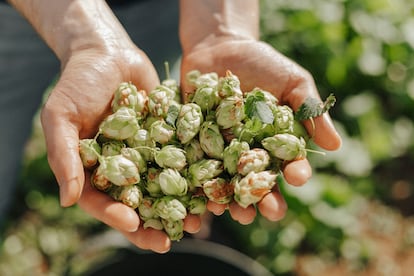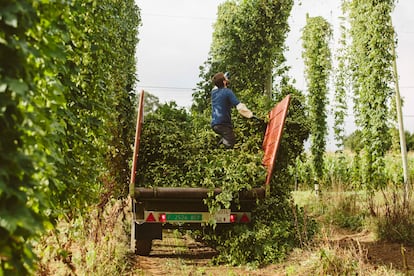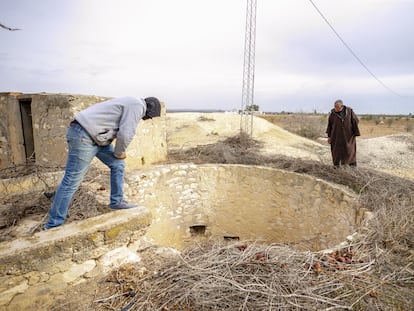Heat threatens the taste and aroma of European beers
Climate change has been reducing the harvest and quality of hops for decades

Water, yeast, barley malt and hops. Those are the ingredients of beer, the world’s third most-consumed beverage after tea and water. Climate change has long threatened the grain’s production, but, according to a new study, it has already been damaging the production of hops, another key ingredient in beer, for decades. For some time now, major European growing areas have seen both their yields and the quality of their product reduced by global warming. Looking ahead, the study indicates that plantations in Spain and other southern European countries will be hardest hit by the changes.
Benedictine nun and church doctor Hildegard of Bingen is believed to have been the first to add hops to beer almost a millennium ago. Back then, the beverage spoiled easily. But the Humulus lupulus flower, a plant in the Cannabaceae family (the same family as hemp), is a natural antibacterial that stabilizes the brew by slowing down the growth of microorganisms. The addition also introduced that characteristic aroma and bitterness of hops into beer, which the nun probably did not intend. Although the Egyptians and Sumerians were brewing beer millennia ago, the modern version of the drink is the result of the German nun’s idea to infuse it with such bitter flowers.
A group of Czech and German scientists wanted to find out how the ongoing climate crisis affects hops production. To do so, they selected five of the most famous hops-growing regions, three in Germany, one in Slovenia and one in the Czech Republic. This trio of countries encompasses almost 90% of the hops-growing areas in Europe. The scientists looked at the amount of hops flowers produced between 1970 and 2020. They also examined another key piece of information: the amount of lupulin contained in hops flowers. This resin contains the alpha acids that impart bitterness and determine the quality of the hops. Researchers then cross-referenced the figures for each harvest with various meteorological parameters, such as temperature, rainfall and hours of sunshine during the critical moments of bearing fruit and harvesting.
The study’s results were just published in the scientific journal Nature Communications and show that hops flowering has sped up by as many as 20 days in the last half century. This acceleration has serious consequences, as Martin Mozny of the Global Change Research Institute of the Czech Academy of Sciences, the study’s lead author, says: “As temperatures increased, the onset of the phenological phases occurred earlier. The problem lies in the shift of the generative phase of hops to a period of longer days. All of this has a negative effect on the alpha quantity and aroma content.” In the weeks during which hops grow up to their usual six meters in height, the plant needs lots of light. But when the plant stops growing and it’s time to bear fruit, excess heat can kill the flowers.
The advance of hops phenology has had a considerable impact; production has decreased by between 0.13 and 0.27 tons per hectare, depending on the area. In Spain, the current average for a good crop yield is 1.6 tons per hectare. The decline in yields has been more marked since the mid-1990s. The decline ranges from 9.5% in Tettnang, Germany, to 19.4% in Celje, Slovenia. The other key variable is the presence of alpha acids. Their concentration has decreased by as much as 34.8% in the hops harvested in the Slovenian region.
The research allowed its authors to determine that the lack of water and drought is particularly detrimental to the quantity of the crop. Meanwhile, excessive heat damages the concentration of alpha acids. Hops are a very demanding and delicate plant. They can only be cultivated at certain latitudes, ranging roughly from the north of Germany to the north of Spain. Hops require a lot of water and moisture, so they are planted near rivers. But between the festivities of St. Joseph (March 19) and St. John (June 23), when the plant awakens from its winter dormancy and grows several meters, it needs many hours of light. The flowers bear fruit over the rest of the summer and are harvested between the end of August and the end of September. Climate change is now altering this whole cycle.

Based on observations from the past 50 years, in the second part of the study the researchers projected them into the future, using a climate model with the most likely emissions scenario and a calculation of precipitation and temperature. Everything about hops is getting worse: yields could drop by up to another 18.4% and alpha content could fall by an additional 20% to 30.8% in these areas. But the article tries to scale its calculations to the whole of Europe. Outside these three countries, the main hops-producing areas are in southern England, northern France and Spain and, further east, in Croatia, Bulgaria, southern Poland and eastern Ukraine. According to the researchers’ estimates, southern hops-growing areas will fare the worst, especially Spain and Portugal.
In Spain, hops are grown on 621 hectares of land. according to data from Spain’s Ministry of Agriculture’s Statistics Yearbook, in 2020, 1,024 tons of hops flower were obtained. To get one liter of beer, one gram of hops is needed; that quantity is then added to the broth by infusion. Over 90% of Spanish hops production occurs in two regions of León, particularly in the one irrigated by the Órbigo river, but that yield does not cover the needs of the national brewing industry. Agricultural engineer Javier Fraile is the technical manager of the León Hops cooperative, which brings together the vast majority of producers in the area and sells around 97% of León’s product. “We are at the southern limit of where hops can be produced,” he explains. This area is also climatologically optimal; it has the right days and hours of light for hops, and “the photoperiod is a key element that regulates its flowering,” Fraile adds.
On the impact of climate change, Fraile warns that it is difficult to separate its effect from other factors. “The problem is that the different varieties don’t live forever. The ideal is 15 years of production,” he explains. Hops plants live for about 20 years and their production differs in their early and later years. He says that this could affect the study’s results. But climate change is causing problems: “In the 1980s, powdery mildew [a fungus] plagues appeared in August; now we get it two months earlier.
The first attempt at industrial hops production took place in Spain in the context of World War I. José Luis Olmedo, R&D project manager at Cosecha de Galicia, a company belonging to the Hijos de Rivera Corporation (the producers of Estrella Galicia), says: “It was the founder José María Rivera who introduced hops.” Actually, it was agronomist Leopoldo Hernández. The two teamed up to bring in hops for fear that the Great War would prevent purchasing them from abroad.
“It’s very finicky,” Olmedo says of the plant: “The alpha acids in hops are very sensitive to temperature. Their bitterness and aromas depend on the variety, as well as on the soil, humidity and temperature.” For almost 20 years, Olmedo has been working on reintroducing hops cultivation in Galicia. This year’s harvest was lower than in previous years because of the weather. The months of June and August have been the hottest in the past decade, and in April and May, when the plant emerges from dormancy, there has been rainfall well below the average of the past 10 years. Olmedo also notes the problem of increasingly mild winters. “The plants start to sprout earlier, and a late frost kills them.”
Faced with such an uncertain future, Hijos de Rivera and other breweries are looking for ways to adapt to the new climate reality. The Galician brewery has a project underway with Ekonoke, an initiative of researchers from the Autonomous University of Madrid. Their idea is to grow hop plants indoors, in greenhouses, to control all variables. Although their slogan, “we are on a mission to save the world’s beer,” may seem excessive, Olmedo reminds us that, unlike the annual harvest abroad, here they hope to have four harvests a year. “It’s our plan B,” he concludes.
Sign up for our weekly newsletter to get more English-language news coverage from EL PAÍS USA Edition
Tu suscripción se está usando en otro dispositivo
¿Quieres añadir otro usuario a tu suscripción?
Si continúas leyendo en este dispositivo, no se podrá leer en el otro.
FlechaTu suscripción se está usando en otro dispositivo y solo puedes acceder a EL PAÍS desde un dispositivo a la vez.
Si quieres compartir tu cuenta, cambia tu suscripción a la modalidad Premium, así podrás añadir otro usuario. Cada uno accederá con su propia cuenta de email, lo que os permitirá personalizar vuestra experiencia en EL PAÍS.
¿Tienes una suscripción de empresa? Accede aquí para contratar más cuentas.
En el caso de no saber quién está usando tu cuenta, te recomendamos cambiar tu contraseña aquí.
Si decides continuar compartiendo tu cuenta, este mensaje se mostrará en tu dispositivo y en el de la otra persona que está usando tu cuenta de forma indefinida, afectando a tu experiencia de lectura. Puedes consultar aquí los términos y condiciones de la suscripción digital.
More information
Archived In
Últimas noticias
Welcome to the post-religion era: The idea of Christianity as the absolute truth has become obsolete
‘I thought you would like it’: The risky sexual practice popularized by TV shows and TikTok
The digitalization of tourism: ‘They promise experiences and gave us the worst possible one’
Mexican peso defies uncertainty with forecasts of a new period of stability in 2026
Most viewed
- Sinaloa Cartel war is taking its toll on Los Chapitos
- Reinhard Genzel, Nobel laureate in physics: ‘One-minute videos will never give you the truth’
- Oona Chaplin: ‘I told James Cameron that I was living in a treehouse and starting a permaculture project with a friend’
- Why the price of coffee has skyrocketed: from Brazilian plantations to specialty coffee houses
- Silver prices are going crazy: This is what’s fueling the rally











































